There was a bit of confusion as to whether I was going in the first place, but after many of my other summer plans had fallen through, I was pretty determined to get up to the Harrison Hut for a week of hard work and beautiful scenery. I had never even been past the first clearcut on the trail, so I wanted to contribute to this project. I had never built a hut, but I hoped that I would be able to help and learn a ton in the process.
I committed too late to get a spot in Roland’s car, but then Jeff Mottershead said he wanted to fly up on the helicopter with his six year old son, Devlin, and there would be a spare seat for me! I would get to ride up in the helicopter. Although many other people may see helicopters as everyday transport, I have never been on one and was super excited, both to get up to the hut and get to ride up in the helicopter!!
Jeff was going to be installing the new and improved Barr Creek Bridge and it was going to be driven up on a huge flat bed truck, driven by Mike Cancilla and I was to ride up with the big truck and keep Mike company. We met up with Jeff at Taylor Way to trade the Horned Van for the flat bed truck. The truck was huge but Mike had some fun driving it up and I don’t think we caused too much of a traffic jam on the sea to sky. In Pemberton, we drove over to the airport and checked in with Blackcomb aviation. Andy gave us a radio to talk with the helicopter when he was close by. We then drove out the logging road to wait for pick up. Driving the huge truck down the logging road was hilarious; it has the stiffest suspension, so every little rock had us bouncing around the cab, laughing the entire time. After flying through some puddles we found the Horned Van at a nice clearing, parked the truck and sat to wait for the helicopter.
Helicopters are strange creatures, like huge awkward dragonflies. Thankfully we had the radio as the helicopter tried to fly past us, to a different 2WD parking area. We called him back and he landed in a huge whirlwind of dust. The pilot, Chris, had a helper/loader and they examined the bridge and we discussed the plan. We were then given the safety talk, which include how to get out of the heli if it were to end up on its side and how to not get our heads chopped off by the rotors. Devlin’s eyes were quite big at this point.
With the plan set, we loaded all the gear into the machine, hopped in and put on our earmuff/radios. The helicopter feels so strange lifting off smoothly vertical from the ground. One second you hear the rotors hit full speed and then we were free from the ground, defying gravity and all that! One of the coolest things was to see the landslide devastation from the air. We also circled around where the Barr Creek bridge was to be dropped and then headed over to the hut. This was my first view of the area and it was amazing, peaks and glaciers all around, with little lakes and complicated moraines. I was surprised to see that there were people at the hut waiting for us! Roland and his carload had beat us up there!
After circling a few times to find a good spot to land, where flat spots are far and few between, Chris, the pilot, tried to put us down on one spot, but after a few bounces, left, right, forward a bit and then back, he decided it wasn’t good enough and we flew around some more to find a better spot.
We finally landed and the rotors spun to a stop. The others joined us at the landing and helped to unload and carry everything back to the hut.
Jeff ran off at this point to the Barr Creek Bridge area to meet the bridge when it was dropped off. We sorted through the massive amount of food and waited for the other loads.
A side note about food, which was to become a major point of constant discussion for the rest of the trip. Originally, Roland had made up a menu of good food for 5 people for 5 days. Rueben decided it was bland added his own items to it. Although I had been told there would be enough food for me, I had a fear of starving, so I brought more food. As we were unpacking, we realized we probably had enough food to have a banquet everyday for a while. Some highlights included the 12 boxes of mac and cheese, too many cans of ‘kippers’, 2 kilos of milk powder and this huge bag of porridge. Ross insists that the kippers were not real kippers, and I didn’t want to get anywhere near them. In the end we probably had enough food to feed 7 people for 7 days, which meant that for the rest of trip we ate and ate and ate. Meals resembled something that would make Hobbits proud; breakfast, second breakfast, elevensies, lunch, afternoon tea, afternoon snack, dinner…
We started work right away. In fact, the hut door was already painted by the time we landed. Tyvek comes first and we got out the roll and started covering the front and back of the hut.
The first three days I hiked down to Barr Creek with Jeff and Devlin, to install the new bridge. Jeff had a huge number of tools with him and at first I thought he must be nuts to have brought all this stuff! But in the end I think that we used every single tool, and needed each one as well to get the job done properly. I also learned that the spud wrench is the most wonderful and amazing thing I have ever used. It will be the next tool I buy. Jeff set up a handline and put Devlin in a harness so he could walk across the bridge without having his hand held and without fear that he would trip and be washed away downstream.
First thing was to disassemble the bridge so it could be installed. I was handed the torque wrench and the spud wrench and told to go at it. We started with the expansion joint furthest from the hut and as I took things apart, Jeff put them back together in place. This also involved hoisting the old bridge and putting the pieces underneath. Tools: small chain hoist and slings.
Everything had to be attached to the handline, the bridge pieces and tools, so that they didn’t end up swimming downriver. In the end, I think we only lost one nut (my fault) and a washer or two. Pretty good track record, all things considered.
Getting the first few pieces in place went slowly, but then it got easier and faster. It was interesting to be lying down on the bridge over the rushing stream trying to put nuts and bolts in place and torque them down, oh yeah, these nuts and bolts are on the bottom side of bridge. I got better at that over time too.
By the end of the first day we had installed the first span and disassembled the rest. Good progress, so Jeff said. Devlin and I started back to the hut, and Jeff finished up some things.
We got back to the hut a bit ahead of Jeff and I got started with the others putting up the siding on the front and back sides.
We fell into a groove pretty quickly, with Roland getting up around 6-6:30 and making the first round of porridge. We woke up more slowly and wandered down to eat the first meal of the day. We generally worked until 6pm and someone made dinner, who ever made dinner got to pick what to make. We all sat in the hut or outside on the rocks to eat. Then, back to work until it was too dark to see. We were bad enough at hitting nails instead of our fingers that trying to do this by headlamp was just asking for trouble.
Having a 6-year-old around did cause some funny discussions. In talking about the new outhouse, there was some talk about the infamous ‘shit beaver’. The ‘shit beaver’ is some animal that eats outhouses and their contents, and scatters used toilet paper all over the place. We think it is a marmot. After referring to this ‘shit beaver’ several times, we all realized that maybe using such words in front of Devlin might not be the best. Jeff then had to ask Devlin if he understood that using the phrase ‘shit beaver’ in his first grade class would not be appropriate. After a long pause, he said he did. I guess time and his teacher will tell us.
The stars during the first few days were amazing, so much so that Cassandra slept outside to see them all night. In the end she was plagued by too many curious little shit beavers.
So Devlin, being 6 and all, walks a bit slower than the average person, which leaves me plenty of time to eat the blue berries, or are they black huckleberries, anyway they turn your tongue and apparently your whole mouth blue and purple. By the time we reached the bridge one day, Jeff looked at me and merely said, ‘eat a few blueberries?’ or something along those lines. So tasty.
The second span was completed on the second day, it was a bit easier since the rocks in the stream allowed us to access the underside of the bridge, though installing around the repair work made things a bit more interesting. But with Devlin manning the chain wrench and Jeff making huge holes with the hammer drill, we were finished by about 5 and back to the hut by 7.
The last day of the bridge involved removing the old bridge parts, ie breaking off the old bolts by bending them back and forth with a wrench. In this, I was useful, but learned that putting your whole weight against the bolt and then having the wrench side off does not end well for your knuckles. Oh well. There is a bumper sticker on the Horned Van that says, ‘I busted my knuckles at Pick a Part.’ I need a sticker that says, ‘I busted my knuckles on the Barr Creek Bridge.’
We also got to mix up concrete and set the expansion joints permanently on the concrete stands that had been previously installed. I learned I like mixing concrete.
Lowering the bridge in place and putting the final nuts on was nice. The bridge had been successfully installed. Wahoo! We took some victory pictures and headed back to the hut to see how things were going.
By the time I got involved with the hut, some of the hard part of the siding installation was finished, the oddly shaped ends with their peaked tops, doors and windows meant a lot of cutting shapes in steel with tin snips. Some things had also been learned, such as that punching holes in steel was way easier to do before you had it propped up again the wall and were standing on a shaking aluminum ladder. Also, we needed another ladder, and a tall one. Rueben used the 4 spare 16 ft 2×4’s ‘dunnage’ from the bridge to construct the mother of all ladders. Tall enough to reach the peak of the roof from the side of the hut, sturdy enough to not feel like you were going to die at any moment, the thing took 4 people to move when we needed to switch it from one side of the hut to the other. Needless to say we tried to avoid this at all costs.
So the siding was installed on the bottom of the hut first. Cassandra had the idea of installing a guide 2×4 along the bottom to make sure the sheets were straight and to hold them up while screwing them on. This made the sheets on the bottom relatively easy and fast to install. But how were we going to get the ones at the top on the hut? They were too high to reach from the ground and if all the people on the ladders were holding them, then it would be hard to screw them in place at the same time. I am not sure how we decided this was the best way, but somewhat inspired by Roland and his ladder ‘jumping’, we settled into a technique that went a bit like this…
1) Get the wooden ladder in place next where the sheet was to be installed, Rueben climbs up ladder.
2) Place the aluminum ladder where the sheet was going to go, Caitlin climbs up ladder
3) Place bench under ladders, Ross and Dave or Cassandra manoeuvre sheet into place.
4) Lift sheet until it touches the aluminum ladder
5) Ready? Up! With each shove of the sheet upwards, Caitlin would push the ladder away from the roof, allowing the sheet to move upwards slightly. But then it would be pinned back in place as the ladder came back in place against the hut, keeping it from falling on the heads of those on the bench.
6) Make sure the sheets line up and put screws in place.
7) Move the ladders over and repeat
This actually worked, and wasn’t the worst system ever. By the time Rueben and I had gotten all the screws in place, the next sheet was pre-punched and ready to go.
While we were jumping ladders all over the hut, Jeff was digging the biggest outhouse hole Ross (who has emptied the Brew outhouse) had ever seen, using Devlin as some sort of height gauge. It will take many, many years to fill. He and Roland constructed the outhouse and fortified it against the shit beavers.
Everything takes longer than you think. Everything. Time flies when you are working and the sun always sets too soon. Maybe it was our inexperience, (actually I am pretty sure it was), as we got faster over the days, but by the time it was Wednesday, our scheduled time to leave was tomorrow, we weren’t done, in fact we had about 2 more days of work to do.
A note about tools. With sometimes 7 people trying to work at the same time, we were a bit short on tools, and the ones we had seemed to like to explode sometimes. To punch holes there were two punches, one of which broke half way through the job; we then resorted to using nails. To drive the punch or nails, you had two options, hammer or hatchet, but we eventually ended up using some nice rocks. To drive the screws, we had an awesome hand drill, and a small ratchet that started shedding parts and eventually wouldn’t hold on to a screw at all. We replaced it with vise grips holding the bit. We were constantly looking for tools and borrowing them from others, trading the #1 snips for the #2 snips, the hammer for the hatchet, the drill for the ratchet, depending on who needed them more. At some point Roland decided it was better to get up before us all, and work on the outhouse by headlamp, partially to make sure he had all the tools to himself.
After some discussion over dinner on Wednesday, it was decided that Jeff and Devlin would leave as planned, and Cassandra (instead of me) would go with them as she needed to get back to town. The rest of us would stay and try to get the work done.
And then there were 5. We worked hard and tried to work fast, and ate more food. We still had a ton of food to eat, and the kippers, but I didn’t count those as food per se.
Friday morning dawned. The roof was finished, but the gable edge for the front and back were still left and being very difficult to install. The difficulties of getting straight flat sheets of steel to conform to a curved hut had been tackled, but seriously getting a long, L-shaped piece of steel to fit a curved hut was really getting the best of us. It didn’t want to bend right, we had cut it to allow the bending but it still didn’t want to lie flat. We cut it some more, it turned into this weird steel zig-zag. We groaned. Roland told us it looked like shit. It did look like shit. I tried to fix it again. It still kind of looks like shit, but you know, it adds character to the hut right?
It took us most of the morning to get the first four pieces up. And then about 1.5 hours to get the first of the upper pieces up. Roland wanted to leave by 2pm to hike to the logging road. He and Dave left by 2pm.
And then there were 3. Ross, Rueben and I tackled the 3 upper pieces of the gable edge things. The first one took too long. We discussed the options, leaving the work undone and hiking to meet Roland, getting the work done and staying the night, hiking out all the way tomorrow, or trying to get the work done and hiking out to meet Roland, with some hiking done by headlamp.
I pushed to get the work done, and we busted our butts to do it. We got faster and were finally done by 5pm. In the mean time, the 3rd person, since only two could be up the ladders, cleaned up the hut and packed up the gear. We also fixed the door! Oh yeah, did I mention, that after a week of glorious sunny weather, it was finally pissing rain?
We also had to nail the old outhouse shut and move The Decider, the book that has resided in the old outhouse, providing both entertainment and maybe spare toilet paper to many an outhouse user for some time now.
By 5:45, we were crossing the stream and on our way, bidding a sad (at least for me) farewell to our home for the past week. The hut gleamed, an armoured oasis in a wild and beautiful place.
We stopped briefly to admire the Barr Creek Bridge, and pick up some of the old bridge parts, some heavy hunks of metal. The headlamps came out just past Pika creek and we arrived on the logging road to find Roland and Dave tucked in their tent away from the rain. We couldn’t be bothered to cook food in the rain and curled up to sleep.
In the night, Ross and Rueben had two creatures visit them. The first was a little shit beaver, aka the pack rat, which had come into their vestibule and decided to eat the leather off the ankle of Rueben’s boot. After chasing it away, they settled into an uneasy sleep, to be awoken by Ross’s cry of pain, an enormous ant had decided to latch on to his neck. After being stunned by a blow from a headlamp, the ant took a pair of tweezers to remove it.
We woke up, ate breakfast and cleared camp. The rain was kind enough to hold off until we had started to hike again. How generous.
We hiked at a nice slow and steady pace, with me trying to find all the berries within reach to eat. At the end of the second clearcut, we saw familiar faces! The VOC trail work party had made it! It was really funny to see them, for one workhike to pass off to another, a passing of the baton or something like that. We were able to give them some beta as to where the trail could use the most work, and in turn they told us some stories that involved the engine falling out of the Horned Van and Jeff, Devlin and Cassandra on a bus to Vancouver. We would only hear the rest of that story once back in Vancouver.
The Jeep was a welcome sight, thankfully free of its old and distressed piece of pumpkin pie, but still bearing some seriously distressed bananas that only Roland would eat.
Taking off wet hiking boots and putting on dry socks is one of the more wonderful feelings at the end of a trip like this, and we drove back to Pemberton while munching on the cookies Ross had left in the car. We did pass some people trying to find the hot springs, and getting lost in the maze of logging roads. Hot springs looked to be a popular place that weekend.
There had been a running joke in the hut, that we would stop at the One Mile in Pemberton, an upstanding restaurant or something, while being dressed in the grubbiest clothes possible. I had never been there, so we decided to stop to grab some food, even if we were slightly cleaner than we once had been. We walked into what looked like a burger joint, only to be told we would have to wait about 25 minutes for our food. We walked out and drove to Splitz in Whistler, which took us about 25 minutes.
Getting back home was really odd for me. This was probably the longest camping trip I had been on, and part of me was craving the solitude of home and the fluffiness of my bed. But when I got there, I realized everything was too big and too quiet. I missed the constant chatter and companionship, the questionable singing around the table at night, the discussions of shit beavers, Jeff’s stories from his roller coaster mechanic days, talk about what we were going to do the next day and what we were going to eat. I boiled water by pushing a button, where was the Coleman stove that needed to by coaxed to life? Where were my friends to share my tea bag with? Who had made the milk from powder?
These feeling wear off eventually and life goes back to normal, but the wonderful memories remain. I spent as much time on the ladder as I could, partially so I could get the best views of the mountains and glaciers around the hut. I can’t wait to go back.
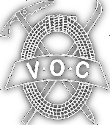
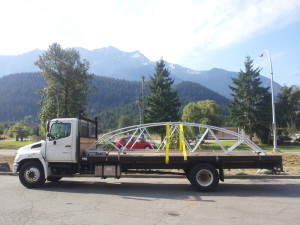
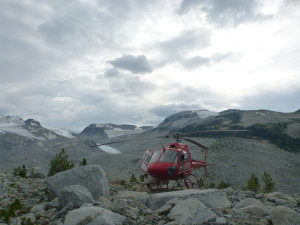
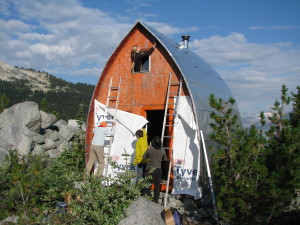
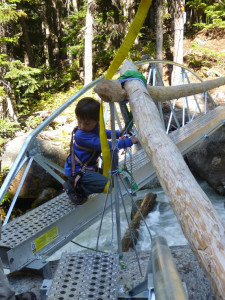
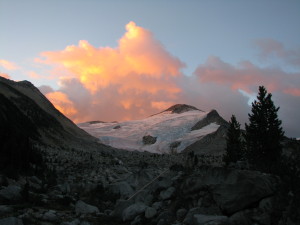

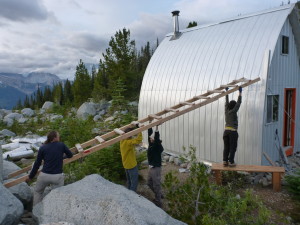
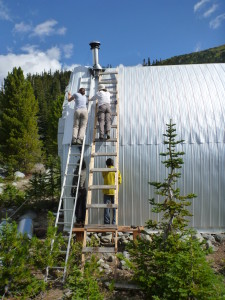
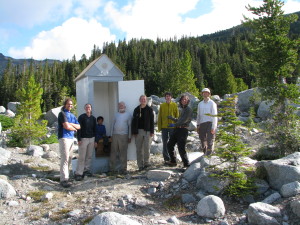
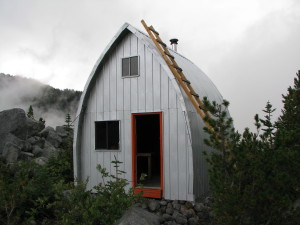
What an article! Fully enjoyed reading it, and thanks for leaving some berries behind for us.
Great trip report! That sure is a tone of work you guys did, thanks!
Thanks for all your hard work! The hut looks great and hopefully will last another 30 years.
Amazing work guys! My appreciation for this is huge. The hut looks amazing and that bridge looks awesome!!
Just Wow! Thanks for the hard work and the great TR!